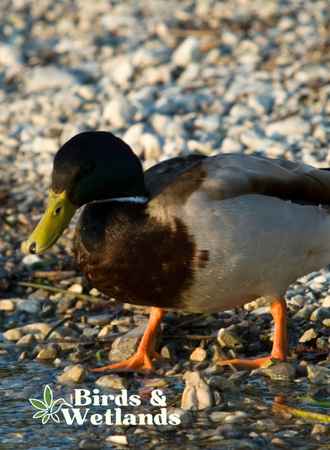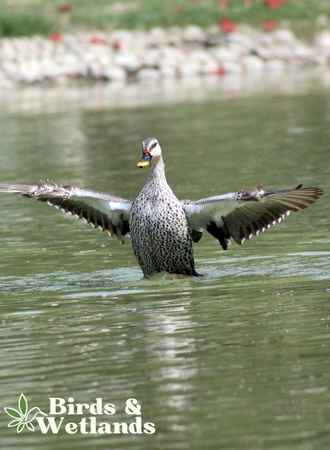The duck’s webbed feet are one of the most interesting and distinctive body parts. There are numerous names for duck feet, but what is their official name?
Duck feet are commonly referred to as “webbed feet” due to the unique web-like structure between their toes. This design aids ducks in their swimming, allowing them to paddle and move efficiently in the water. The individual digits or ‘toes’ on a duck’s foot are known as “phalanges.”
Key Takeaways on What Are Ducks’ Feet Called
- Ducks have webbed feet, which are also called “palmate feet.” This type of foot is common among semi-aquatic birds and aids in efficient swimming and steering.
- There are four main types of webbed feet found in bird species – Palmate, Totipalmate, Semipalmate, and Lobate. Each type is characterized by a different level of webbing and toe orientation, affecting the bird’s swimming efficiency and style.
- Palmate feet, found in ducks, have the front three toes webbed and facing forward, while the small back toe is unconnected and points backward.
- Ducks’ webbed feet primarily aid in swimming but are also used for walking and flying. The feet help in propelling the birds through water at high speeds.
- Webbed feet have evolved mainly to improve ducks’ swimming abilities and their overall aquatic life.
- A duck’s feet are an essential part of maintaining its body temperature through a process called counter-current heat circulation. The feet act as natural radiators, helping control body temperature and minimize heat loss in cold conditions.
- Ducks’ feet are often orange in color, indicating good health and sufficient vitamin intake. The bright orange color of their feet and bills also plays a role in attracting the opposite sex during mating season.
What Are Duck Feet Called?

A duck’s foot is called a palmate. Its distinct webbed foot is essential to its aquatic lifestyle. These birds’ broad, webbed toes provide them with exceptional support and agility in the water, allowing them to navigate swiftly through streams and currents.
The small hallux (hind toe or back toe) is elevated above the waterline, allowing many species of ducks to maintain a firm grip on the ground even in slippery conditions. Due to this distinctive morphology, palmate feet are one of the distinguishing characteristics of numerous aquatic animals.
How Do Ducks Use Their Feet?
Ducks use their webbed feet in many ways. For instance, a puddle duck uses its webbed feet to submerge its head into the water to search for food. Ducks control their body temperature using their feet.
Here are other ways ducks use their webbed feet:
Swimming
Ducks are known for their webbed feet, which allow them to move swiftly and precisely through the water. When swimming, waterfowl push forward to propel themselves, allowing them to cover vast distances beneath the surface.
Flying

Ducks use their feet as rudders. Before landing, they lower their feet and spread the webbing between their toes, which creates additional drag that slows them down and makes their landing smoother and maximizes surface area.
Preening
To maintain their feathers in pristine condition, most birds and ducks use a substance known as preen oil. Preen oil is the reason why ducks have waterproof feathers.
However, ducks cannot use their beaks to apply this essential substance to all of their body parts. Instead, they utilize a distinctive grooming method known as scratch-preening.
Do Ducks Swim Underwater Using Their Webbed Feet?
Some ducks dive underwater to forage food. These ducks use their webbed feet to propel themselves underwater, allowing them to dive to great depths.
The webbings are long, flat extensions of their feet that are ideal for kicking with minimal resistance through the water. The webbed feet of diving ducks provide the propulsion force that propels them forward underwater.
Why Are Ducks’ Feet Orange?

It is common knowledge that many ducks have bright orange feet. Despite its odd appearance, this feature serves a crucial function.
The vibrant hue of a duck’s feet indicates that it is healthy and receiving all the necessary vitamins and nutrients. During the duck’s mating season, having well-nourished, vibrant feathers can be the difference between attracting a mate and going without one.
How Many Legs Do Ducks Have?
The ducks have two legs in total. Nonetheless, ducks have four limbs, including two legs and two wings.
Ducks use their two legs to paddle and propel themselves across the water’s surface when swimming underwater.
Do Ducks Have Feelings on Their Feet?
Due to the absence of nerves and blood vessels in their feet, ducks’ feet do not feel cold. Even with these characteristics, frostbite can still occur under extreme conditions. Even ducks that spend most of their time in water are susceptible to severe weather and must seek shelter when the temperature drops too low.
Ducks’ feet act as natural radiators. These water birds rely on other sensory inputs to ensure their safety when exposed to extreme cold.
During cold weather, many ducks and other aquatic birds tuck their large flat feet into their bodies. It keeps their legs and feet warm. It also helps in maintaining body temperature and to minimize heat loss.
What Are the Different Types of Webbed Feet?

Most semi-aquatic birds have webbed feet. Here are the different types of webbed bird feet:
Lobate Feet
Lobate feet are a foot structure found in numerous aquatic bird species. The front three toes of lobate feet are bordered by lobes of skin, which are small, flat flaps of webbing that help these birds swim more efficiently. These lobes remain closed when the bird is on land, allowing it to traverse dry terrain easily.
Totipalmate Feet
In totipalmate feet, all four toes are joined by a webbing. These creatures’ fully webbed feet allow them to swim and dive effortlessly, enabling them to hunt for food in the open ocean. These muscles are highly adaptable and flexible, allowing the webs between the toes to expand and contract as necessary.
Semipalmate Feet
Animals with semipalmate feet have specialized appendages used for grasping and locomotion. As their name suggests, these feet resemble the traditional palmate foot structure. The primary difference is that the webbing on these toes only extends halfway down, as opposed to the entire length.
Examples of birds with semipalmate feet include plovers, sandpipers, herons, and chickens.

